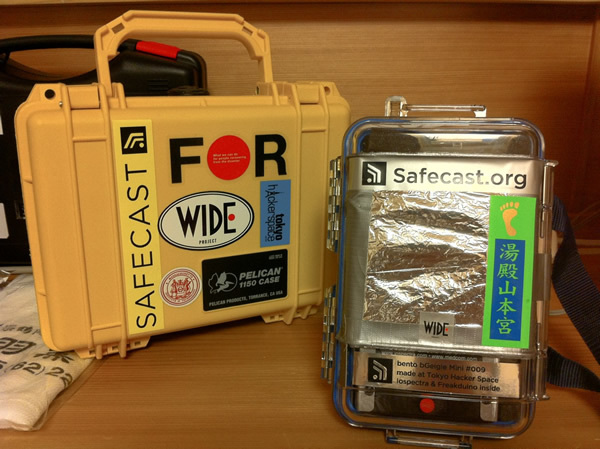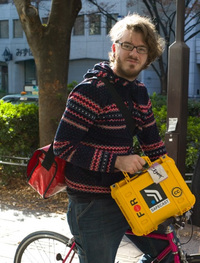Disasters can create unlikely heroes, and Robin Scheibler is one of them. While hanging out at the Tokyo Hackerspace, the Swiss software engineer became part of an international effort, called Safecast, to detect radiation after the nuclear meltdown at Fukushima. Scheibler specializes in algorithms and was working at NEC when the Tohoku earthquake struck. In the weeks that followed, people tried largely without success to determine how far the radiation might have spread.
Safecast began as an email thread between three men: MIT Media Lab Director Joi Ito, activist-entrepreneur Sean Bonner, and Pieter Franken, a researcher at Keio University. The trio envisioned a people’s network of radiation sensors, with data collected by citizens and put online for the benefit of researchers, policy makers and everyone else. Notably, the crowd-sourcing project has had no official connection with the Japanese government--although government researchers can, and presumably have, benefitted as well.
Scheibler’s involvement with Safecast came not from his expertise, but from a willingness to tackle one of the project’s most fundamental problems in assessing the spread of radiation over a wide area: how do you collect radiation data from a car? Scheibler had majored in communications engineering at the Ecole Polytechnique Federale de Lausanne, also known as the Swiss Institute of Technology. For Safecast, he ventured into less familiar territory, becoming the project’s embedded systems developer. That leap was made easier by Arduino, an open-source prototyping integrated circuit card intended for “artists, designers, and hobbyists”
Scheibler first came to Japan in March 2007, spending almost a year as a research intern at NEC’s System IP Core Laboratory, where he worked on a simulator written in MATLAB. After going back to Switzerland to graduate, he returned to NEC, this time doing speech processing research. In his free time, Scheibler is a climber and hiker, as well as snowboarder and telemark skier. He speaks five languages, including his native French, fluent English and conversational Japanese. Scheibler has played the drums for over a decade and has kept a blog, called Tabemonogatari, on his adventures with Japanese cuisine. The blog hasn’t been updated in a while. Scheibler has been busy.
- How did you first get involved with Safecast?
In February 2011, I joined the Tokyo Hackerspace in Shirokanedai. This is a community-oriented creative space where developers can go to work on their projects. One month later, the Tōhoku earthquake happened, followed by the meltdown. In response, some people at the Hackerspace started to work on radiation sensing projects, including one guy who figured out how to upload analog data from an old Geiger counter by wiring an Arduino board to the speaker leads. That project was featured on the Hack A Day site, where people from Safecast saw it. Pieter Franken, who leads Safecast’s Japan operations, dropped by. Out of those discussions, we put together a Geiger counter with a GPS and a small netbook--and we had our first mobile sensor.
- Your project is called bGeigie.
Yes. The “b” is for “bento” because it looks like a bento box, and “Geigie”
, of course, is short for “Geiger counter.” - How new is the idea of a mobile radiation sensor?
Of course “War-driving,” where you map open Wifi networks from a car, has been going on for some time. But the idea of sensing environmental factors this way is only in the pilot project stage. Another example is in Zurich, where people are putting pollution sensors on buses. That project started more or less at the same time as ours. So I think we are seeing a natural evolution of the technology.
- Why is mobile sensing only now taking off?
For one thing, the hardware is now incredibly cheap compared with years past. Even with our first prototype, we were able to put it together with off-the-shelf hardware.
- Was this the homebrew version of a commercial product?
For radiation sensing, I don’t think so. This is probably the first device in its class. We’ve been contacted by various people interested it.
- What role does the Arduino board play?
We could have plugged the Geiger counter into the serial port of the PC, but the Arduino board proved the easier approach. The Arduino is very popular among developers in the Hackerspace because it is both cheap to purchase and easy to program. We use it to interact with the physical world--in this case, the pulses coming from the Geiger counter--then aggregate that with GPS data and send it to the computer. Because Arduino is an open source project, it is widely supported on the Internet. And because it has been integrated into many systems, there’s lots of resource material available.
- Your background is more in conventional software development than firmware. What differences did you encounter?
The main difference for me is that with an embedded system, you can have bugs that are not caused by the software, but by the hardware--and those can be very tricky to debug. But the actual programming process for firmware turned out to be pretty straightforward. At its core, this is a small piece of software controlling a tiny chip that is, itself, interacting with external elements. An advantage of the Arduino board is that it makes it easy for people with a conventional software background to do this kind of firmware development. You can code in C, which is familiar and developer-friendly. The basic idea is that you code the microcontroller's input and output pins. This can be fairly primitive: you are setting bits on registers that have obscure names listed on a data sheet. The Arduino people have put a nice wrapper around this so that you can address pin functions by their number. Basically, the Arduino environment hides the ugly details of the microcontroller and lets you just program in C.
- What did the resulting code look like?
The code is very compact--and the work it does is pretty simple. Basically, microcontrollers are coded in an infinite loop. The code checks the GPS and retrieves any data. Every time a Geiger counter pulse is received, an interrupt routine records it. Every five seconds, you write the number of pulses and the latest GPS information. That’s it.
- What about the hardware?
Originally, we used a Geiger counter, GPS dongle and netbook. In the self-contained unit we now use, an Arduino extension board replaces the dongle and netbook. The board was specifically designed for this project by another member of Safecast and the Hackerspace: Akiba from freaklabs.
org. We build these units ourselves, housing the electronics in Pelican cases, which are tough and watertight. The biggest physical modifications are the holes we drill in the cases for straps. The work takes maybe a couple of hours. We’ve made about 40 devices so far, each representing about $1,000 in equipment cost. However, the Geiger counter accounts for about $600 of that. So with a homebrew Geiger counter and slightly less expensive parts, one could replicate the system for around $200--making it accessible to many hobbyists. Now we are now looking into adding memory. Right now, we have 2K of RAM―so it’s extremely resource constrained. Adding new features tends to make the device crash. So I’m working on the design for a new board with a slightly more memory: 16K. At the same time, Safecast member Joe Moross is making the device easier to use and more durable.
- How is the bGeigie used in the field?
We have volunteers in the Fukushima area who drive their cars around their neighborhoods. The bGeigie is basically a box with two straps and one switch. So the volunteers just close a window on the straps so that the device hangs on the outside, turn on the switch, and drive. When they finish, they take the SD card out and email the data it contains. The data is then aggregated at the back-end of our website and published as a set of color-coded maps. All the raw data is freely available on the website under a non-commercial Creative Commons license.
- This a crowd-sourcing application that people probably couldn’
t imagine. The earthquake and the meltdown changed a lot of things. I don’t think the project would have happened, otherwise.
- Will Safecast stay in Japan, or will it expand beyond?
Our aim is global. Obviously, it is very much needed in Japan, but the goal is to do it for the whole planet. We are doing this in very small steps. We have now one device that is traveling in the United States. The idea is that people from one Hackerspace will drive it to the next Hackerspace. It will be interesting to see what is out there. Here in Japan, people have already been very surprised to find radiation in unexpected places--not just in Fukushima and not just from the meltdown. For example, someone found a high radiation spot in Tokyo. That turned out to be bottles of radium that were buried in the ground during the war. Another Safecast member with a Geiger counter noticed very high radiation in the train. It turned out that a man sitting next to him just had medical treatment.
- What’
s been the response of Japanese people to the project? It’s been great. The Hackerspace is largely made up of foreigners, but on the scene we have lots of Japanese who have contacted us to do volunteer measuring. At the beginning, people were understandably reluctant to do that. But once we started and got covered on Japanese TV, lots of people contacted us.
- Did you say that the Tokyo Hackerspace is largely made up of foreigners?
There are a few Japanese members, but the core are people from the United States and Europe. Attracting new members is a challenge in itself, and the language issue doesn’t help.
- You mentioned sensors on buses. Where do you think mobile sensors are going?
Mobile sensing has a lot of potential because you can sample so much more territory. The key has been to make use of some of the infrastructure that is already in place. In cities, for example, you have buses, taxis, delivery trucks, and postmen. They are all traveling, if not the same route, then at least in the same area, every day. That’s a different view of the world than a stationary sensor, which measures the same place over time. You sacrifice that depth with a mobile sensor, but for a lot of measurements, that’s a tradeoff worth making. You’re trading a little bit of time for quite a bit of space.
- And you can measure not just radiation but other kinds of pollution?
All kinds of things, even pollen counts.
- Since the meltdown, many people have been afraid to come to Japan for fear of radiation exposure. Should they be fearful?
We, of course, have been asked this question many times. But it is a tricky one to answer as there is little understanding and even less consensus in the scientific community as to the effect of exposure to low-dose of radiation. For short-term visitors on business or holiday, I think there is little to be afraid of since the cumulative dose is what matters for low radiation exposure. Also, the location is important. Tokyo, unlike what many media have been reporting, has fairly low contamination. It’s actually lower than Hong Kong, for example, where, ironically, many people fled following the meltdown.
Of course other personal circumstances like pregnancy, induced stress, or small children have to be taken into account. For some people, the trip might just not be worth the risk, whatever that might be, and this is a perfectly legitimate reason to renounce a visit if it isn’t really necessary.




